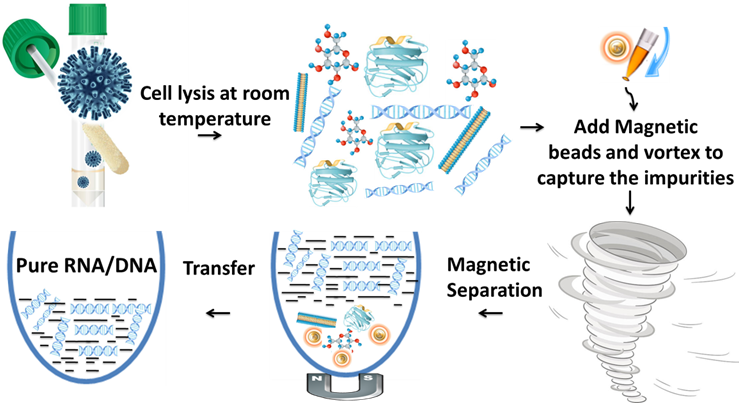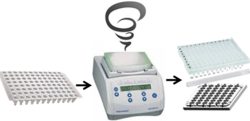- +1 858 909 0079
- +1 858 909 0057
- [email protected]
- +1 858 909 0079
- [email protected]

Products
Components
Shipping conditions: At ambient temperature
Components
BcMag™ L27 Beads
10x Lysis Buffer
DTT
Storage
4°C
4°C
-20°C
Cat. No. AR101 (50 Preps)
2.5 ml
0.6 ml
15.4 mg
Cat. No. AR102 (100 Preps)
5.0 ml
1.2 ml
30.8 mg
Shipping conditions: At ambient temperature
Handling and Storage: Store the kit components according to the table Above on arrival.
In the field of molecular biology and diagnostics, obtaining high-quality nucleic acid from biological samples is crucial for downstream applications such as PCR, RT-PCR, and LAMP. The quality and quantity of nucleic acids obtained from the samples can significantly impact the sensitivity and specificity of the assays performed.
One of the most significant challenges in nucleic acid extraction is the presence of inhibitors such as proteins, salts, and other contaminants that interfere with the downstream applications. Additionally, the use of organic solvents and chaotropic salts in the extraction protocol can be time-consuming and may result in the loss of nucleic acids during the process.
The BcMag™ One-Step Swab/Saliva Viral RNA-DNA Purification Kit provides a convenient and fast method for the purification of RNA and DNA from saliva samples. The negative selection chromatography magnetic bead technology used in the kit efficiently removes PCR inhibitors, providing a pure and high-quality DNA/RNA. The one-step protocol eliminates the need for extraction buffers, organic solvents, and chaotropic salts, reducing the risk of DNA/RNA loss and carryover of extraction buffers, and the yield of the purified nucleic acid is almost 100%. The procedure is simple and quick, allowing for the processing of hundreds of saliva and nasal-pharyngeal swab samples in less than 15 minutes. The purified nucleic acid is ready for use in downstream applications such as PCR, RT-PCR, RT-qPCR, LAMP, and RT-LAMP, making the kit ideal for a wide range of research applications.

1.
Add cell lysis buffer to the sample and mix well.
2.
Incubate at room temperature for 5 minutes.
3.
Add the magetic beads and mix by pipetting or vortexing to capture the impurity.
4.
Magnetic capture the beads and aspirate the supernatant containing the pure ready-to-use DNA/RNA

1.
Fast and convenient protocol
The one-step protocol of the kit is simple and quick, just one-step, one tube, no liquid transfer, allowing the processing of hundreds of saliva and nasal-pharyngeal swab samples in less than 15 minutes. This feature makes it an ideal solution for large-scale research studies and diagnostic laboratories.
2.
High yield of purified nucleic acid
The one-step protocol of the kit is simple and quick, just one-step, one tube, no liquid transfer, allowing the processing of hundreds of saliva and nasal-pharyngeal swab samples in less than 15 minutes. This feature makes it an ideal solution for large-scale research studies and diagnostic laboratories.
3.
Efficient removal of PCR inhibitors
The negative selection chromatography magnetic bead technology used in the protocol efficiently removes PCR inhibitors, providing a pure and high-quality DNA/RNA. This feature ensures that the extracted nucleic acid is free from contaminants that may interfere with the downstream applications.
4.
Elimination of extraction buffers, organic solvents, and chaotropic salts
The protocol eliminates the need for extraction buffers, organic solvents, and chaotropic salts, which reduces the risk of DNA/RNA loss and carryover of extraction buffers. This feature also eliminates the need for hazardous organic solvents, making the kit safe and easy to use.
5.
High Throughput
Designed for high-throughput applications, this kit allows you to process hundreds of samples simultaneously, making it ideal for large-scale testing or research projects. Compatible with many different automated liquid handling systems.
The following protocol is an example. The protocol can be scaled up or down as needed.
Notes
●
DNA Yield: Varies (depends on sample size and type)
●
DNA Size: Varies (depends on the quality of starting material)
●
Since there is no concentration step in the protocol, the concentration of the nucleic acid depends on the quality and quantity of the sample used.
●
Quantification of the nucleic acids: Use only fluorescence methods such as qPCR, Qubit, and Pico Green.
●
OD260 methods such as Nanodrop and UV-spectrophotometry are not-suitable.
●
For long-term storage, store the extracted nucleic acids at -20°C.
Materials Required by the User
Item
Magnetic Rack for centrifuge tube
** Based on sample volume, the user can choose one of the following magnetic Racks
Source
• BcMag™ Rack-2 for holding two individual 1.5 ml centrifuge tubes (Bioclone, Cat. No. MS-01)
• BcMag™ Rack-6 for holding six individual 1.5 ml centrifuge tubes (Bioclone, Cat. No. MS-02)
• BcMag™ Rack-24 for holding twenty-four individual 1.5-2.0 ml centrifuge tubes (Bioclone, Cat. No. MS-03)
• BcMag™ Rack-50 for holding one 50 ml centrifuge tube, one 15 ml centrifuge tube, and four individual 1.5 ml centrifuge tubes (Bioclone, Cat. No. MS-04)
Item
BcMag™ 96-well Plate Magnetic Rack.
Source
• BcMa™ 96-well Plate Magnetic Rack (side-pull) compatible with 96-well PCR plate and 96-well microplate or other compatible Racks (Bioclone, Cat. No. MS-06)
Item
Adjustable Single and Multichannel pipettes
Item
Centrifuge with swinging bucket
Addition items are required if using 96-well PCR plates / tubes
Vortex Mixer
** The user can also use other compatible vortex mixers. However, the Time and speed should be optimized, and the mixer should be: Orbit ≥1.5 mm-4 mm, Speed ≥ 2000 rpm
Eppendorf™ MixMate™
Eppendorf, Cat. No. 5353000529
Tube Holder PCR 96
Eppendorf, Cat. No. 022674005
Tube Holder 1.5/2.0 mL, for 24 × 1.5 mL or 2.0 mL
Eppendorf, Cat. No. 022674048
Smart Mixer, Multi Shaker
BenchTop Lab Systems, Cat. No. 5353000529
1.5/2.0 mL centrifuge tube
96-well PCR Plates or 8-Strip PCR Tubes
Items
Magnetic Rack for centrifuge tube
** Based on sample volume, the user can choose one of the following magnetic Racks
Source
●
BcMag™ Rack-2 for holding two individual 1.5 ml centrifuge tubes (Bioclone, Cat. No. MS-01)
●
BcMag™ Rack-6 for holding six individual 1.5 ml centrifuge tubes (Bioclone, Cat. No. MS-02)
●
BcMag™ Rack-24 for holding twenty-four individual 1.5-2.0 ml centrifuge tubes (Bioclone, Cat. No. MS-03)
●
BcMag™ Rack-50 for holding one 50 ml centrifuge tube, one 15 ml centrifuge tube, and four individual 1.5 ml centrifuge tubes (Bioclone, Cat. No. MS-04)
BcMag™ 96-well Plate Magnetic Rack
●
BcMa™ 96-well Plate Magnetic Rack (side-pull) compatible with 96-well PCR plate and 96-well microplate or other compatible Racks (Bioclone, Cat. No. MS-06)
Adjustable Single and Multichannel pipettes
Centrifuge with swinging bucket
Addition items are required if using 96-well PCR plates/tubes
Vortex Mixer
** The user can also use other compatible vortex mixers. However, the Time and Speed should be optimized, and the mixer should be: Orbit ≥1.5 mm-4 mm, Speed ≥ 2000 rpm
Eppendorf™ MixMate™
Tube Holder PCR 96
Tube Holder 1.5/2.0 mL, for 24 × 1.5 mL or 2.0 mL
Smart Mixer, Multi Shaker
Eppendorf, Cat. No. 5353000529
Eppendorf, Cat. No. 022674005
Eppendorf, Cat. No. 022674048
BenchTop Lab Systems, Cat. No. 5353000529
Eppendorf™ MixMate™
Tube Holder PCR 96
Tube Holder 1.5/2.0 mL, for 24 × 1.5 mL or 2.0 mL
Eppendorf, Cat. No. 5353000529
Eppendorf, Cat. No. 022674005
BenchTop Lab Systems, Cat. No. 5353000529
1.5/2.0 mL centrifuge tube
96-well PCR Plates or 8-Strip PCR Tubes
PCR Plates/Tubes
! IMPORTANT ! If using other tubes or PCR plates, make sure that the well diameter at the bottom of the conical section of PCR Tubes or PCR plates must be ≥2.5mm.
A. Sample Preparation
Follow these general guidelines when handling forensic samples:
●
Avoid overloading the sample to allow efficient mixing of Lysis Mix with the sample.
●
Only synthetic fiber swabs and rigid plastic rods should be used. Cotton fiber contains substances that inactivate the virus and can inhibit the RT-PCR test leading to false negatives.
Sample
Example Sample Input
Buccal swab
1.
General Swab Collection Instructions
Mouthwash
1.
Add 500µl-1000µl mouthwash into a new 1.5 ml centrifuge tube.
2.
Centrifuge at 14,000 rpm for 5 minutes to pellet the cell
3.
Aspirate all the liquids
4.
Add 1 ml ultrapure water to the tube, Vortex, and centrifuge at 14,000 rpm for 5 minutes to pellet the cell.
5.
Remove all the liquids
6.
Resuspend the cell pellet with 100μl ultrapure water.
Note: Food, drinks, smoking, or chewing gum should be restricted up to 30 min to 1 h before giving your saliva sample
B. Beads and Solution Preparation
! IMPORTANT !
1.
Before pipetting, shake or Vortex the bottle to completely resuspend the Magnetic Beads.
2.
Do not allow the magnetic beads to sit for more than 2 minutes before dispensing.
3.
DTT solution preparation: Provide DTT as powder and dissolve at a concentration of 1M in ultrapure water. For example, 15.4 mg dissolved in 100µl ultrapure water. It is stable for years at -20°C. Prepare in small aliquots, thaw it on ice, and use and discard. Store them in the dark (wrapped in aluminum foil) at -20°C. Do not autoclave DTT or solutions containing it. Avoid multiple freeze-thaw cycles.
4.
Dilute DTT to a concentration of 10 mM from stock with ultrapure water and use it immediately. Discard unused DTT solution.
C. Isolation Procedure
! IMPORTANT !
●
Pipet up and down premix beads solution in a reagent reservoir until the solution is homogeneous before dispensing.
●
Do not allow the magnetic beads to sit for more than 5 minutes before dispensing.
1.
Pipette 100 µl of the sample into a suitable container or microcentrifuge tube.
2.
Add 10x lysis buffer to the sample at a 1:10 ratio. This means adding 10 µl of the 10x lysis buffer for every 100 µl of the sample
3.
Prepare a 10 mM DTT solution by diluting the DTT reagent in ultrapure water. Pipette 3 μl of the 10 mM DTT solution for every 100 µl of the diluted sample. For example, if you have 200 µl of the diluted sample, add 6 µl of the DTT solution.
4.
Mix the sample gently to ensure thorough mixing. Incubate at room temperature for 5 minutes.
5.
Add 50 µl BcMag™ L27 Beads. Mix the sample with beads by slowly pipetting up and down 20-25 times or Vortex the sample at 2000 rpm for 5 minutes (see picture)

6.
Place the sample plate/tube on the magnetic separation plate for 30 seconds or until the solution is clear.
7.
Transfer the supernatant to a clean plate/tube while the sample plate remains on the magnetic separation plate. The sample is ready for downstream applications. Using 1-5 μl in a 25μl RT-PCR or qPCR.
D. Troubleshooting
Problem
Low DNA/RNA Recovery
Probable Cause
Poor starting sample material
Suggestion
Problem
Ct Value Delays
Probable Cause
Too many PCR inhibitors in the sample.
Suggestion
Problem
Ct Value Delays
Probable Cause
Recovery RNA/DNA is so low.
Suggestion
Problem
Probable Cause
Suggestion
Low DNA/RNA Recovery
Poor starting sample material
Ct Value Delays
Too many PCR inhibitors in the sample.
Recovery DNA is so low.
Magnetic Beads Make Things Simple